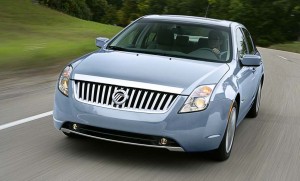Ford Motor Co. may eliminate as many as a third or more of its current nameplates if CEO Alan Mulally has his way, the executive arguing that a slimmer line-up will translate into fatter profits for the healthiest of Detroit’s Big Three automakers.
Mulally provided a vague outline of his plan during a speech to the Confederation of British Industry in London, saying he sees as few as 20 products in the Ford portfolio and no more than 25. That compares with the current count of 36 individual models. And that’s already down sharply.
“There will be less than 30, on our way to 20 to 25,” Mulally said when asked about the future Ford line-up. “Fewer brands means you can put more focus into improving the quality of engineering.”
Such a move would run in sharp contrast to the general industry trend dubbed fragmentation. As competition has heated up over the years manufacturers have responded by offering more and more niche products — sometimes filling in white space that their lines didn’t previously cover but also by offering multiple products where one model previously sufficed.
This proliferation has been especially apparent in the luxury segment where players like Mercedes-Benz have tripled and even quadrupled their model mix. Ford’s Lincoln brand is also undergoing an expansion under Mulally – but that is offset by the fact that Ford is preparing to abandon the luxury brand’s sibling Mercury marque and its four models.
The Ford line-up has already taken some sharp cuts, dropping from 97 when the CEO joined the company from Boeing four years ago. But that huge deproliferation has been largely the result of Ford’s shift in emphasis back to its core brands.
Step-by-step, Mulally ordered the elimination of the once-promising Premier Automotive Group, selling off European nameplates Aston Martin, Jaguar, Land Rover and, most recently, Volvo, which was purchased by the Chinese Zhejiang Geely Holding Group.
While Ford is now seen as the strongest of the U.S. brands it was in dire shape when Mulally took the helm and almost immediately mortgaged most of the maker’s assets to raise some much-needed cash. That line of credit proved more critical than even the biggest skeptics realized when the U.S. economy began to crash in late 2008 – and helped Ford avoid going into Chapter 11 and asking for the federal bailouts needed by rivals Chrysler and General Motors.
“It was absolutely clear we had to simplify Ford dramatically,” Mulally said before heading to the Paris Motor Show, which stages its media preview later this week.
One way Ford is simplifying its line-up is by sharing products across its empire rather than building rather than building market-specific models. As a result, the new Fiesta sold in the U.S. shares about two-thirds of its parts with the version available in Europe.
The move benefits consumers as well as the manufacturer, its dealers and its suppliers, Mulally told the Confederation.

